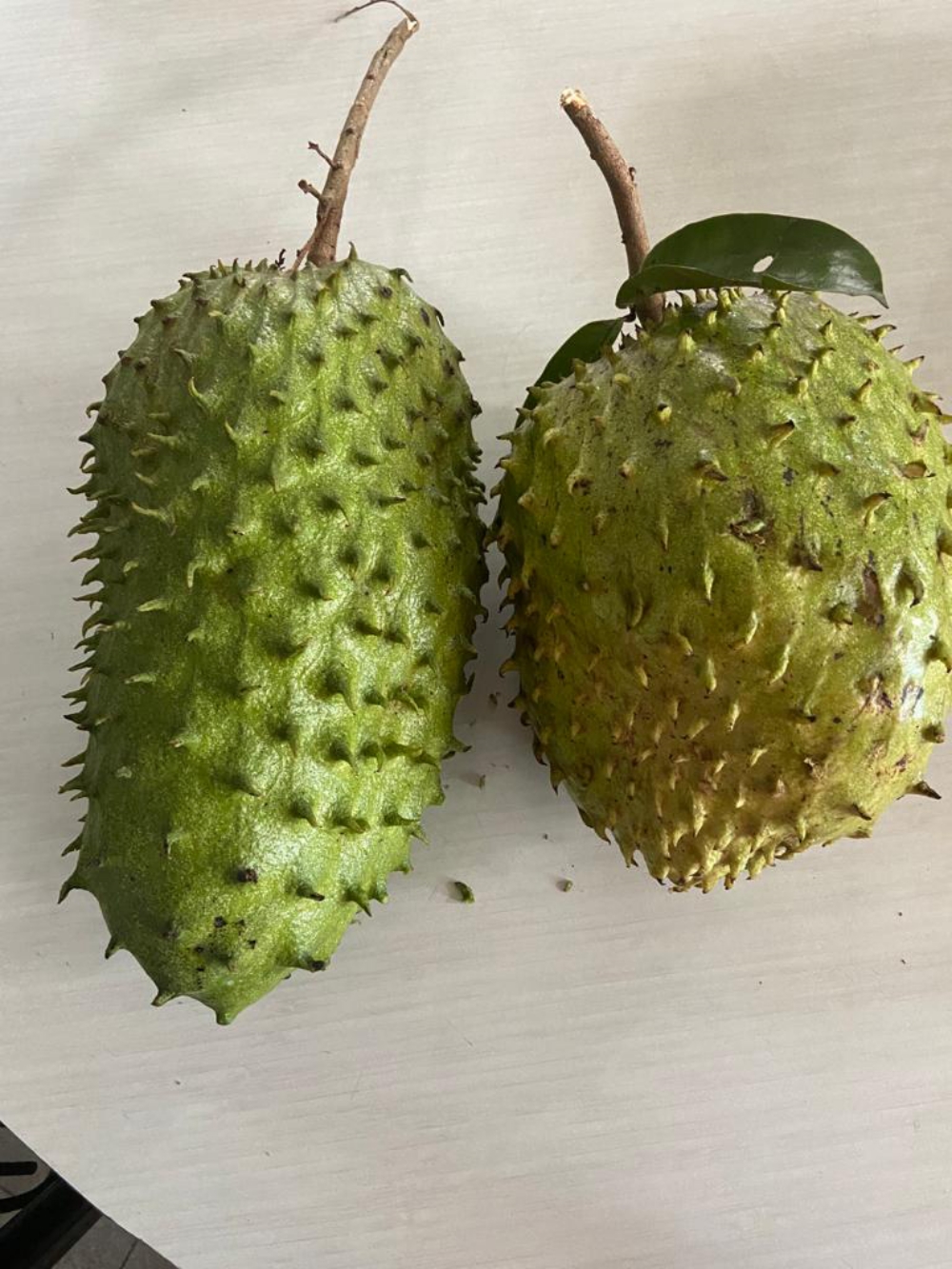
A large soursop fruit may reach a weight of 2kg.
THE soursop (Annona muricata) belongs to the Annonaceae family originating from South America. It is found both wild and cultivated throughout the West Indies and south of Mexico, down to the Peru and Argentina. It is now found growing in the tropical regions in Australia and India, and is also a popular home-garden fruit tree in Sarawak.
It was probably introduced together with other fruits such as custard apple and sweet sop (annona).
The tree is an evergreen – slender, low-branching and bushy, and may grow up to a height of a few metres. The leaves emit a faint odour when crushed. The flowers grow either as single blooms or in small clusters, each with two layers of fleshy petals. The flowers are hermaphrodite.
Aided pollination helps set the fruit sets as the male pollen and the female ovules do not mature at the same time.
The fruit is a syncarp (consisting of many individual small fruits or drupes), typically ovoid or ellipsoid in shape. There are irregular shapes also, most likely due to improper carpel development.
A large fruit may reach a weight of 2kg. It contains 62 to 85 per cent pulp, and 25 per cent skin in terms of weight. The pulp can be eaten fresh, and also be stored at a low temperature that would retain the taste and aroma. In a pureed form, it can become a juice concentrate for jelly, jam or a refreshing drink.
I think many have experienced the different tastes of the soursop – some are sweet, some are tart, and a few are downright sour. There are about 60 varieties of the genus Annona.
The soursop can also be divided according to its taste. The two types known are the Guanaba azucaron (sweet, can be consumed raw) and the Guanaba acida (very sour).

Soursop is now a popular home-garden fruit tree in Sarawak.
Health benefits
Medical studies reveal a range of health benefits of soursop such as aiding digestion, antibacterial properties, stabilising blood sugar level and treating arthritis. Some studies have also found that it may assist in reducing cancer growth.
Soursop leaf tea is proven effective in treating fever, gall bladder problem and dysentery, as well as preventing leg cramps and even anaemia.
With significant Vitamin C, magnesium, potassium, phosphorus, folate and calcium contents, soursop can help boost immunity, growth and tissue repairment.
Major producers
Soursop is a subsistence farm fruit tree commonly planted in Southeast Asia and there are large plantations in Mexico and South American countries such as Brazil and Venezuela, registering annual production that could reach 10,000 metric tonnes.
This fruit can be grown in many soil types, but sandy to sandy loam soils of medium texture are the most suitable. The soil pH should be between 6 and 6.5. For local planting, usage of lime can reduce the acidity of the soil common in Sarawak.
The soil should be rich in organic matter and low in salts. The tree can tolerate dry soil conditions, but not prolonged wet conditions. Best growth can be achieved in rich, well-drained medium as poor drainage may result in ‘collar rot’, floral abscission and root rot.
Propagation
The soursop is usually propagated by seed and with this in mind, there is a rapid loss of viability of the seeds after removal from the fruit. The seeds should be sown in trays or containers under moist and shady conditions. Germination takes 15 to 30 days.
Propagation by cuttings and air-layering is not very common. Grafting has been used in my farm for propagation of the same quality fruit for new planting.
Successful grafts are cut out from the mother plant, planted in polybags and left for the three months before field-planting.

Soursop juice can be made into a refreshing drink and nowadays, one can easily buy it in the forms of cordials or canned drinks in most supermarkets.
Planting and maintenance
The plot should be well-prepared by deep ploughing and levelling. A spacing distance of 4m to 6m is recommended for field planting. The tree would need some gentle pruning to allow the formation and pollarding, which is to make the tree low enough for easy harvesting, and also for assisted pollination.
Nutrition is important to ensure the quality of the fruits, especially with the use of boron. It can counter the ‘blacking’ of the pulp when the soil lacks the element.
Usage of sodium borate should rectify the problem.
Forty grams of nitrogen and 60g of potassium should be applied to the one-year-old plant. In terms of the fertiliser phosphorus, or NPK pellet, application can be increased three times a year as the tree becomes more mature for fruiting. Organic fertiliser such as chicken manure can be added too.
Annona species require 27 to 35 days for flowering, from initiation to anthesis. The flowering periods usually follow vegetative flushes. The flowers exhibit both dichogamy and protogynous nature, and pollen is released during the early hours of the day.
The problem is the differences in the readiness of the ovule hidden inside the bracts of the flower, which could make assisted pollination somewhat difficult. However, natural pollination by insects or wind can do the cross-pollination job. The flowers also emit a fragrance that attracts the insects.
Pests and diseases
There are ways to rid of troublesome pests such as the mealy bugs, scale insects, fruit flies and wasps in the fruit.
Spraying with ‘malathion’ (organophosphate insecticide) can help, and so does bagging.
The plant can also be affected by foliar diseases such as anthracnose (fungal disease that can cause leaf spots, cupping or curling of leaves, and early leaf drop).
The ‘pink disease’ is often the major cause of shoot dieback; hence, the need for early pruning.
Fruits are sometimes damaged by black canker (fungal) and black lesions on the skin too.
Happy Gardening!
from Borneo Post Online https://ift.tt/v2jG0xm
via IFTTT

No comments:
Post a Comment